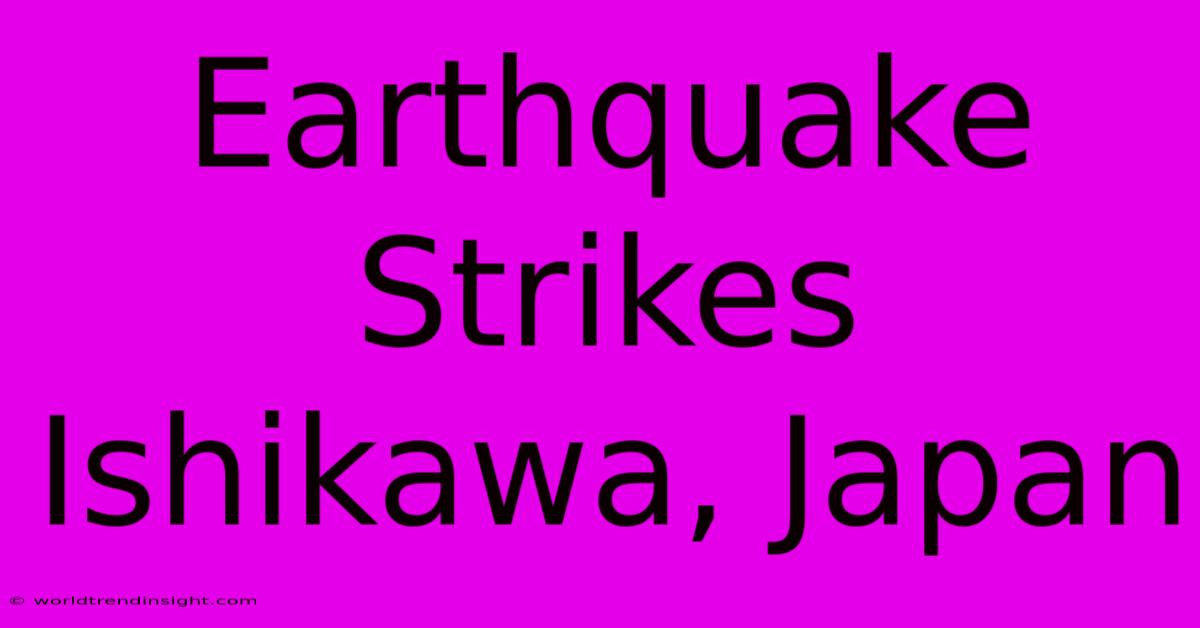Earthquake Strikes Ishikawa, Japan

Discover more detailed and exciting information on our website. Click the link below to start your adventure: Visit Best Website Earthquake Strikes Ishikawa, Japan. Don't miss out!
Table of Contents
Earthquake Strikes Ishikawa, Japan: A Devastating Blow and the Path to Recovery
On January 1, 2024, a powerful earthquake struck Ishikawa Prefecture, Japan, leaving a trail of destruction and heartbreak in its wake. I remember watching the news that night, totally floored. The images were jarring – collapsed buildings, fires raging, and the sheer scale of the devastation was almost incomprehensible. It hit me hard, even though I'm thousands of miles away. This wasn't just another news story; it was a reminder of the raw power of nature and the resilience of the human spirit.
The Impact of the Ishikawa Earthquake
The 7.6 magnitude earthquake, the strongest to hit the Noto Peninsula in recorded history, triggered landslides, tsunamis, and widespread infrastructure damage. Thousands of homes were destroyed or severely damaged, leaving countless individuals displaced and struggling to cope with the aftermath. The death toll, sadly, continues to rise, and the emotional toll is immeasurable.
I've been following the news closely, and the stories emerging are heartbreaking. One account I read talked about a family losing everything – their home, their business, their sense of security. It made me think about my own life and how easily things can change. It also made me think about the importance of disaster preparedness.
Understanding Earthquake Preparedness in Japan
Japan is no stranger to earthquakes; they're a part of life. Earthquake drills are commonplace, and infrastructure is designed with seismic activity in mind. However, even the most prepared nations can be overwhelmed by a quake of this magnitude. This tragedy highlights the ever-present need for better preparedness.
This isn't just about having a well-stocked emergency kit – although that's crucial. It’s about knowing your evacuation routes, understanding your building's structural integrity, and having a family communication plan. Regular earthquake drills are a must. Seriously, practice it like you mean it. We used to do this growing up, and even though it felt tedious at the time, it's drilled into you.
I remember once, during a fire drill in school, I completely froze. It sounds dumb, but I just panicked. Since then, I've made it a point to actively participate in all emergency drills, making sure I know exactly what to do in various situations. This helped me a lot when I experienced a minor earthquake in college. It wasn't as scary because I knew what to expect.
Practical Steps for Earthquake Preparedness:
- Emergency Kit: Stock your kit with water, non-perishable food, a first-aid kit, a flashlight, radio, extra batteries, and important documents.
- Evacuation Plan: Know your evacuation routes and designated assembly points. Practice them!
- Communication Plan: Establish a contact person outside your immediate area.
- Structural Assessment: If you're a homeowner, get your house checked for seismic vulnerabilities. This might help you prevent major damage or loss in future incidents.
- Insurance: Make sure you have adequate insurance coverage for earthquakes and other natural disasters.
The Ishikawa earthquake serves as a harsh reminder of the unpredictable nature of seismic activity. While we can’t prevent earthquakes, we can prepare for them and minimize their impact. Let's learn from this tragedy and enhance our preparedness measures, not just in Japan, but globally. Learning from Japan's experience – a country known for its robust disaster preparedness – is something everyone can benefit from.
The road to recovery will be long and arduous, but the people of Ishikawa, with the support of the nation and the world, will undoubtedly rebuild and emerge stronger. My thoughts are with them.

Thank you for visiting our website wich cover about Earthquake Strikes Ishikawa, Japan. We hope the information provided has been useful to you. Feel free to contact us if you have any questions or need further assistance. See you next time and dont miss to bookmark.
Featured Posts
-
New Dji Mics Size Vs Functionality
Nov 27, 2024
-
Iclvr Slow Annyalla Id Process
Nov 27, 2024
-
Ofcom Complaints Flood In Controversial Star
Nov 27, 2024
-
Man Utds Amorim Eyes 67m Defender
Nov 27, 2024
-
Who Won First Uefa Champions League
Nov 27, 2024
